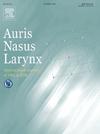Clinical analysis on sarcopenia according to the site of head and neck cancer
IF 1.5
4区 医学
Q2 OTORHINOLARYNGOLOGY
引用次数: 0
Abstract
Objective
In cases of cancer patients with sarcopenia, many adverse effects such as postoperative complications and prognosis have been reported with head and neck cancer. We examined the prevalence and prognosis of sarcopenia according to the site in head and neck cancer in order to clarify the site that require early intervention as the primary endpoints.
Methods
From October 2016 to March 2021, we retrospectively studied 388 cases of 448 primary cases of head and neck cancer who visited our department and for whom measurement using bioelectrical impedance analysis (BIA) and grip strength were possible. 339 cases that had undergone radical treatment were retrospectively examined.
Result
Of the 388 primary cases of head and neck cancer, 102 patients were diagnosed with sarcopenia. The most common site is oral cancer, followed by oropharyngeal cancer, and hypopharyngeal cancer. In terms of the patient background, sarcopenia was significantly more common in patients aged "65 years or older," in those in "stage III or higher, in those in "T3 or higher," in those with a history of drinking alcohol and in those with "site-related swallowing (oral cavity, oropharynx, and hypopharynx)". The prevalence of sarcopenia in terms of stage classification was 25% or more in advanced cancer cases for all sites of head and neck cancers; however, it was observed from stage I or higher for oropharyngeal cancer and stage II or higher for hypopharyngeal cancer. The 3-year overall survival rate for oral cancer, oropharyngeal cancer, and hypopharyngeal cancer was significantly worse in sarcopenic patients than in non-sarcopenic patients; however, for laryngeal cancer and other cancers, while the 3-year overall survival rate was worse in sarcopenic patients than in non-sarcopenic patients, no significant difference was observed.
Conclusion
In cases of head and neck cancer, elderly patients and those with oral, oropharyngeal, or hypopharyngeal cancers, which are closely related to swallowing, tend to be more susceptible to sarcopenia. As prognosis of these sites is also affected by sarcopenia, careful attention should be paid to the presence or absence of sarcopenia. In particular, because patients with oropharyngeal cancer and/or hypopharyngeal cancer are prone to sarcopenia from an early stage, the presence or absence of sarcopenia should be confirmed in the event a suspected lesion is observed in the oropharynx and/or hypopharynx.
头颈癌不同部位肌肉减少症的临床分析。
目的:头颈癌合并肌肉减少症的病例中,有许多不良反应如术后并发症和预后的报道。我们根据头颈癌的部位检查了肌肉减少症的患病率和预后,以明确需要早期干预的部位作为主要终点。方法:2016年10月至2021年3月,我们回顾性分析了在我科就诊的388例448例原发性头颈癌患者,这些患者可以使用生物电阻抗分析(BIA)和握力进行测量。对339例接受根治性治疗的患者进行回顾性分析。结果:388例头颈癌原发病例中,有102例诊断为肌肉减少症。最常见的部位是口腔癌,其次是口咽癌和下咽癌。就患者背景而言,肌肉减少症在“65岁及以上”、“III期及以上”、“T3期及以上”、有饮酒史和“部位相关吞咽(口腔、口咽和下咽)”的患者中更为常见。在头颈癌所有部位的晚期癌症病例中,骨骼肌减少症的分期分类患病率为25%或更多;然而,口咽癌的I期或更高,下咽癌的II期或更高。口腔癌、口咽癌和下咽癌患者的3年总生存率明显低于非肌少症患者;然而,对于喉癌和其他癌症,虽然肌少症患者的3年总生存率比非肌少症患者差,但没有观察到显著差异。结论:头颈癌患者中,老年患者及与吞咽密切相关的口腔、口咽、下咽癌患者更易发生肌肉减少症。由于这些部位的预后也受到肌肉减少症的影响,因此应仔细注意是否存在肌肉减少症。特别是,由于口咽癌和/或下咽癌患者早期容易出现肌肉减少症,因此,在口咽和/或下咽观察到可疑病变时,应确认是否存在肌肉减少症。
本文章由计算机程序翻译,如有差异,请以英文原文为准。
求助全文
约1分钟内获得全文
求助全文
来源期刊

Auris Nasus Larynx
医学-耳鼻喉科学
CiteScore
3.40
自引率
5.90%
发文量
169
审稿时长
30 days
期刊介绍:
The international journal Auris Nasus Larynx provides the opportunity for rapid, carefully reviewed publications concerning the fundamental and clinical aspects of otorhinolaryngology and related fields. This includes otology, neurotology, bronchoesophagology, laryngology, rhinology, allergology, head and neck medicine and oncologic surgery, maxillofacial and plastic surgery, audiology, speech science.
Original papers, short communications and original case reports can be submitted. Reviews on recent developments are invited regularly and Letters to the Editor commenting on papers or any aspect of Auris Nasus Larynx are welcomed.
Founded in 1973 and previously published by the Society for Promotion of International Otorhinolaryngology, the journal is now the official English-language journal of the Oto-Rhino-Laryngological Society of Japan, Inc. The aim of its new international Editorial Board is to make Auris Nasus Larynx an international forum for high quality research and clinical sciences.
 求助内容:
求助内容: 应助结果提醒方式:
应助结果提醒方式:


